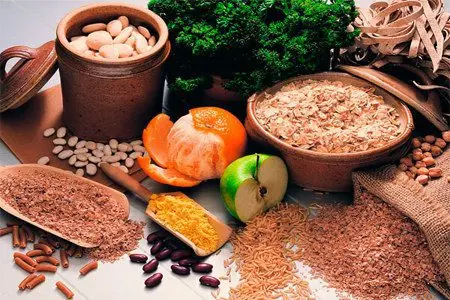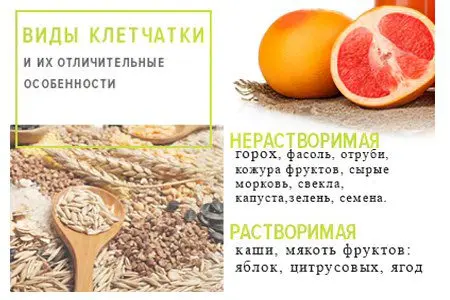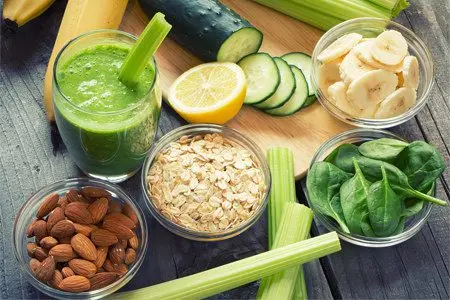Contents
What is fiber?

In some parts of plants, special fibers are formed – cellulose. The peculiarity of these fibers is that they are not affected by enzymes secreted by the upper parts of the digestive tract. Digestion of fiber occurs in the intestines. The most popular sources of fiber are cabbage, bean stalks, and grains. Useful fibers pass through the entire digestive tract to the intestines, where they are processed by beneficial microflora.
The main function of plant fibers is to help the gastrointestinal tract. They help to actively promote the food bolus and fully digest it. Too long a stay of food in the digestive tract causes bloating, flatulence, increased gas formation. Fiber components accelerate the natural process of bowel release. The beneficial properties of plant fibers help to eliminate problems in the work of the stomach and intestines.
Types of Fiber

There are two types of plant fibers:
Soluble fiber – Has the ability to dissolve in the aquatic environment. The fibers are susceptible to the action of enzymes, changing the consistency to a jelly-like one. As a result, food digestion slows down. A person does not experience hunger for a longer time. Eating soluble fiber helps control appetite and help you lose and maintain weight.
Key benefits of soluble fibers:
Decreased levels of “bad” cholesterol.
Controls blood glucose levels. This property is especially valuable for patients with diabetes mellitus, for those suffering from metabolic syndrome.
Removal of toxins from the body, bile acids.
Soluble fiber is rich in citrus fruits, fruit pulp, beans, carrots, peas, oats, flax seeds. The most popular source is pectin. Thanks to pectin, the food changes its structure to a jelly-like one, as it absorbs a lot of liquid.
insoluble fiber – is not able to be digested under the influence of enzymes of the gastrointestinal tract, but actively stimulates the process of excretion of intestinal contents. People who take insoluble fiber note that the problem of constipation is solved very quickly. This type of fiber is found in large quantities in cereals, bran, nuts, and some vegetables. The work of insoluble components is similar to the functions of a sponge that absorbs cholesterol, toxins, salts of heavy metals, radionuclides, and fatty acids. “Filled” fibers are quickly excreted from the intestines.
Fiber can be divided according to other criteria:
Cellulose. In everyday life, it is often called bran, as it is found in large quantities in the shell of cereals. Cellulose stimulates intestinal peristalsis. Due to the rapid passage of food, harmful substances are not absorbed by the intestinal villi.
Pectin. A source of soluble fiber is the skin of fruits, vegetables, and some citrus fruits. Pectin promotes the removal of heavy metal compounds. Food rich in pectin lingers in the stomach, keeping the feeling of satiety for a long time.
Hemicellulose. Semi-soluble fibers actively absorb liquid along with toxic components. A specific process controls the level of cholesterol in the blood, lipid metabolism. The main sources of hemicellulose are oats and barley.
Gum. Beans, a food made from oats, contain valuable soluble fiber. It has an enveloping property. After the gum enters the body, the absorption of glucose through the walls of the stomach and intestines slows down.
Lignin. It is found in large quantities in bran, strawberries and various cereals. Surprisingly, the longer the product lies, the more lignin is formed in it. Insoluble fiber binds to bile, which inhibits the absorption of cholesterol, protects the inner wall of the intestine from toxic components.
How many grams of fiber do you need per day?

It is a mistake to believe that high-fiber foods can be consumed uncontrollably or in large quantities. The recommended doses of plant fibers have been determined, which bring certain benefits to the body. The amount of fiber depends on gender and age.
Daily dose for men:
Up to 50 years – 38 g.
Over 50 years old – 30 g.
Daily dose for women:
Up to 50 years – 25 g.
Over 50 years old – 21 g.
To provide the body with the necessary fiber, it is enough to eat daily a small portion of porridge, a couple of fruits, a small bowl of vegetable salad. There is an opinion of nutritionists that bread should be eliminated from the diet. This is not true – it is important to pay attention to the type of bread. It is better to dwell on products made from wholemeal flour. Such bread stimulates the intestines and does not contribute to the appearance of extra pounds.
On average, for every 1000 calories, there should be 14 to 20 grams of plant fiber.
When do you need more/less fiber?
The body needs more plant fiber in a number of conditions:
During pregnancy. Carrying a child requires an increase in the volume of food portions, and hence, plant fiber.
With age. The maximum consumption of fibers falls on the period of greatest activity – from 14 to 50 years. With the advent of maturity, the need for fiber decreases by 5-10 units.
Vitamin deficiency, anemia of any origin. Fiber cleans the intestinal walls, which facilitates the absorption of vitamins.
Insufficiently active work of the stomach and intestines. The action of plant fibers stimulates physiological processes in the gastrointestinal tract.
Excess weight. Getting rid of extra pounds comes as a result of the normalization of digestive functions.
The amount of fiber should be reduced in a number of cases:
In the acute period of inflammatory diseases of the stomach, pancreas.
With dysbacteriosis.
With flatulence.
The benefits of fiber for the human body

Medical studies have shown that eating fiber significantly improves the quality and length of life. The results of observations suggest that plant fibers are an excellent way to prevent type II diabetes, hypertension, heart disease, obesity and digestive problems.
Protection against diabetes
Introducing fiber into your daily diet prevents spikes in sugar levels after high-carbohydrate foods. It is generally accepted that foods high in fiber have a low glycemic index. This is not entirely true – this quality is inherent only in soluble fibers with a pronounced viscosity. It is the viscous soluble fibers of fiber that help to contain spikes in blood sugar after eating carbohydrates. [1].
A recent study published in 2019 showed that diabetic patients who took 38 grams of fiber daily for six months lowered blood sugar by 28% on their own. [2].
For heart and vascular health
Protects against ischemia of the heart. Several studies conducted over time have shown that high fiber intakes significantly minimize the likelihood of cardiovascular disease. Harvard scientists organized an experiment involving 40 male medical workers. This large-scale study found that high fiber intake was associated with a 40% reduction in the risk of coronary heart disease. [3].
A similar study at Harvard was conducted with the participation of nurses. The results were very similar [4].
Reduces the risk of another heart attack. Fiber fibers have anti-inflammatory properties that protect the heart. The strengthening effect is proven in one of the studies. For nine years after a heart attack, patients received large amounts of fiber every day. It was found that the risk of death is reduced by 25% thanks to cereal dietary fiber. [5].
Lowers cholesterol. Even a small amount of soluble fiber – 2 to 10 g per day – can reduce total cholesterol by 1,7 mg/dL. “Bad” cholesterol is reduced by 2,2 mg/dL. These data were confirmed by 67 independent studies. [6].
Experimentally, it was possible to find out that the most pronounced ability to lower cholesterol has fiber from persimmon pulp. [7].
Reduces pressure. A 25% increase in fiber intake over 6 months resulted in a 15% reduction in systolic blood pressure.
For the intestine
It is an undeniable fact that fiber reduces the likelihood of developing colorectal cancer. In the United States, a four-year study was conducted to prevent the occurrence of polyps. The results showed that eating a lot of fiber reduced the risk of colorectal cancer by 35%. Scientists have proven that the likelihood of reducing cancer is due to the property of fiber to move the food bolus faster through the gastrointestinal tract. Fast passage helps to qualitatively remove undigested food residues, does not allow potential carcinogens to be absorbed through the mucous membrane.
Regular intake of fiber in the body stimulates the production of a special compound – butyrate. It is formed when plant fibers are broken down by bacteria in the lower part of the large intestine. Butyrate prevents the formation of neoplasms in the colon and rectum, suppresses inflammatory processes, which increase the risk of colorectal cancer by almost 500 times. [8], [9].
Reduces the risk of diverticular disease. One long-term study in men found that long-term intake of insoluble fiber reduced the risk of diverticular disease by up to 40%. [10].
The benefits of fiber for women
Fiber reduces the risk of breast cancer, especially when young women eat a fiber-rich diet. The ability of plant fibers to reduce the risk of malignant tumors in the mammary glands has long been known. This is due to the binding of fiber fibers to estrogen. A recent Harvard experiment showed that teenage and young girls taking an extra 10g of dietary fiber daily reduced the risk of breast cancer by 13% to 50%. [11].
Eating plenty of fiber during pregnancy helps protect your baby from asthma. The anti-inflammatory properties of plant fibers, as well as butyrate, facilitate pregnancy. One of the latest studies showed that women who took a lot of healthy plant fibers during pregnancy had children who were not prone to respiratory diseases and bronchial asthma. [12].
Fiber for constipation
Most people know that adding fiber to your diet can help relieve constipation. Vegetable fibers absorb liquid, which increases the volume of feces and facilitates their passage through the intestines.
The fibers that promote water absorption act as a laxative. Fiber, which increases the dry mass of stools, without pronounced absorption of water, causes constipation. A pronounced softening effect is given by soluble fibers that are not amenable to fermentation of the intestinal microflora and form a gel.
Oat, wheat bran have a more active effect than the fiber found in vegetables and fruits. Sorbitol is one type of fiber that has a laxative effect due to the absorption of water into the sections of the large intestine. The record holder for the content of sorbitol is prunes.
Constipation prescription. To prepare a cleansing mixture, you need to take: 200 g of prunes, raisins, dried apricots, and figs, as well as 100 g of dried senna leaves, and 1 glass of honey.
Senna leaves are poured into a glass of hot water, mixed thoroughly and left to swell. Prunes, raisins, dried apricots, figs are twisted in a meat grinder. The resulting mixture is mixed with senna leaves and honey. The mass is thoroughly mixed, transferred to jars and stored in the refrigerator.
The composition is taken for three weeks, 1 tablespoon at bedtime. In the morning there is a soft bowel movement. The laxative mixture is recommended for people suffering from constipation, hemorrhoids, as well as those who want to cleanse the small and large intestines of toxins, mucus and feces.
[Video] Video recipe for this mixture:









